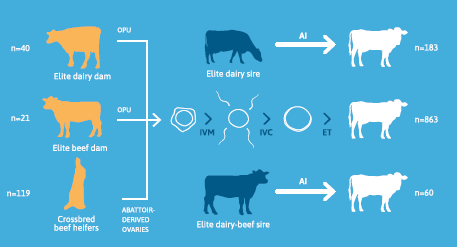Scientific article
Fertility performances of lactating dairy cows submitted to timed artificial insemination or timed embryo transfer with fresh or frozen in vitro produced embryos in a seasonal pasture-based system
Alan Crowe, Jose Maria Sánchez, John Browne, Stephen G. Moore, Michael McDonald, Rafaela Rodrigues, Maria Fernanda Morales, Leandro Orsi De Freitas, Maria Belen Rabaglino, Pedro Pinho, Federico Randi, Patrick Lonergan, Stephen T. Butler
Publication information
European Buiatrics Congress 2025
Objectives
This study aimed to compare pregnancy per service (P/S) in lactating dairy cows following timed artificial insemination (TAI) or timed embryo transfer (TET) using either fresh or frozen in vitro produced (IVP) embryos.
Materials and Methods
Oocytes were collected weekly for up to 9 weeks using transvaginal ovum pick-up from elite dairy donors (ET-DAIRY; n = 40; Holstein-Friesian and Jersey) and elite beef donors (ET-ELITE-BEEF; n = 21; Angus). Both heifers and cows were included in these donor groups. Additionally, oocytes were collected from the ovaries of beef heifers of known pedigree following slaughter (ETCOMM-BEEF; n = 119). After in vitro maturation, fertilization, and culture, single Grade 1 blastocysts were transferred either fresh or after freezing and on-farm thawing into lactating Holstein-Friesian dairy cows synchronized with a 10-day PRID-Ovsynch protocol. On day 0, cows received a 2-mL intramuscular injection of GnRH analogue (Ovarelin, 100 μg of gonadorelin diacetate tetrahydrate; Ceva Sante Animale, Libourne, France) and a progesterone-releasing intravaginal device (PRID Delta; 1.55 g Progesterone, Ceva). On day 7, a 5-mL intramuscular injection of PGF2α (Enzaprost, 25 mg of dinoprost trometamol; Ceva) was administered, followed by a second 5-mL injection of PGF2α on day 8 and removal of the PRID. On day 9.5 (32 hours after PRID removal), a second intramuscular injection of GnRH was given. On day 10, 243 cows received AI (16 hours after the second GnRH), and 863 cows were assigned to receive ET on day 17. Blood samples were collected on day 17 to evaluate serum P4 concentrations. Pregnancy rates were determined between days 32-35 after synchronized ovulation using transrectal ultrasonography. Pregnancy was confirmed between days 62-65 to determine embryonic loss. Pregnancy data were analyzed using generalized linear mixed models, with service treatment (TAI vs. TET) as a fixed effect.
Results
Mean pregnancy per service at day 32 was similar between AI (48.8%) and ET (48.9%) and did not differ between dairy and beef embryos (50.3% vs. 48.1%, respectively). P/S was lower (P = 0.003) following the transfer of frozen embryos compared to fresh embryos (41.6% vs. 56.1%, respectively). Pregnancy loss between days 32 and 62 was higher (P = 0.003) for ET (15.1%) compared to AI (4.7%), with greater losses observed for frozen beef (18.5%), fresh beef (17.3%), and frozen dairy (19.2%) compared to fresh dairy (6.0%). Serum P4 concentration on day 7 was associated with P/S at days 32 and 62. Cows in the lowest quartile for serum P4 concentrations
(Q1) had a lower probability of being pregnant on day 32 (33.4%) compared to cows in the three upper quartiles (45.7%, 55.6%, and 61.2% for Q2, Q3, and Q4, respectively).

Conclusions
Pregnancy per service event on days 32-35 was similar for TAI and TET, although 9.6% of cows initially synchronized for ET were rejected. Of cows that were pregnant on day 32, pregnancy loss was greater for TET than for TAI. P4 concentrations on day 7 were positively correlated with pregnancy outcomes at days 32 and 65.





